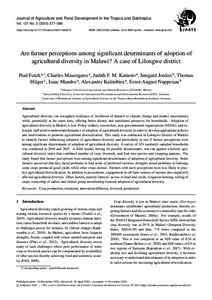| dcterms.abstract | Agricultural diversity can strengthen resilience of livelihood of farmers to climate change and market uncertainties while, potentially at the same time, o ering better dietary and nutritional prospects for households. Adoption of agricultural diversity in Malawi is low. Policy-makers, researchers, non-governmental organisations (NGOs), and extension staff need to understand dynamics of adoption of agricultural diversity in order to develop appropriate policies and interventions to promote agricultural diversification. This study was conducted in Lilongwe District of Malawi to identify factors influencing adoption of agricultural diversity and particularly to test if farmer perceptions were among significant determinants of adoption of agricultural diversity. A survey of 424 randomly sampled households was conducted in 2016 and 2017. A Tobit model, having 16 possible determinants, was run against a holistic agricultural diversity index that combined number of crop, livestock, and fruit tree species and cropping patterns. The study found that farmer perceptions were among significant determinants of adoption of agricultural diversity. Some farmers perceived that they faced problems to find seeds of preferred varieties, droughts posed problems to farming; some crops produced good yields while other crops did not. Farmers with such perceptions were less likely to practice agricultural diversification. In addition to perceptions, engagement in o -farm sources of income also negatively a ected agricultural diversity. Other factors, namely farmers’ access to land and credit, irrigation farming, selling of crops, ownership of radios, and farmer group membership fostered adoption of agricultural diversity. | eng |


